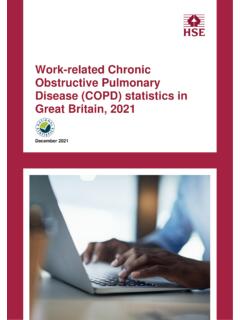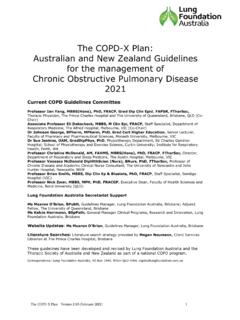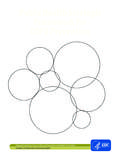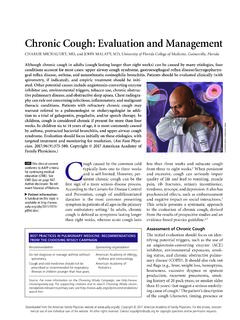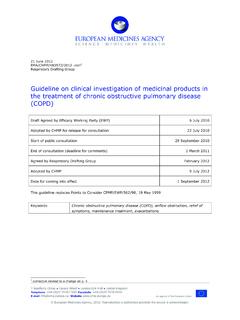Transcription of COMMITTEE FOR MEDICINAL PRODUCTS FOR HUMAN USE …
1 European Medicines Agency Pre-authorisation Evaluation of Medicines for HUMAN Use 7 Westferry Circus, Canary Wharf, London, E14 4HB, UK Tel. (44-20) 74 18 84 00 Fax (44-20) 74 18 86 13 E-mail: European Medicines Agency, 2009. Reproduction is authorised provided the source is acknowledged. London, 22 January 2009 Doc. Ref. CPMP/EWP/4151/00 Rev. 1 COMMITTEE FOR MEDICINAL PRODUCTS FOR HUMAN USE (CHMP) GUIDELINE ON THE REQUIREMENTS FOR CLINICAL DOCUMENTATION FOR ORALLY INHALED PRODUCTS (OIP) INCLUDING THE REQUIREMENTS FOR DEMONSTRATION OF THERAPEUTIC EQUIVALENCE BETWEEN TWO INHALED PRODUCTS FOR USE IN THE TREATMENT OF asthma AND chronic obstructive pulmonary disease (COPD) IN ADULTS AND FOR USE IN THE TREATMENT OF asthma IN CHILDREN AND ADOLESCENTS DISCUSSION AT THE EFFICACY WORKING PARTY September 2000 TRANSMISSION TO CPMP January 2002 RELEASE FOR CONSULTATION January 2002 DEADLINE FOR COMMENTS April 2002 DISCUSSION AT THE EFFICACY WORKING PARTY January 2004 TRANSMISSION TO CPMP April 2004 ADOPTION BY CPMP April 2004 DATE FOR COMING INTO OPERATION October 2004 DRAFT REV.
2 1 AGREED BY EFFICACY WORKING PARTY September 2007 ADOPTION BY CHMP FOR RELEASE FOR CONSULTATION REV. 1 18 October 2007 END OF CONSULTATION (DEADLINE FOR COMMENTS) 30 April 2008 REV. 1 AGREED BY EFFICACY WORKING PARTY January 2009 ADOPTION BY CHMP 22 January 2009 DATE FOR COMING INTO EFFECT 1 August 2009 KEYWORDS Guidance, orally inhaled PRODUCTS GUIDELINE ON THE REQUIREMENTS FOR CLINICAL DOCUMENTATION FOR ORALLY INHALED PRODUCTS (OIP) INCLUDING THE REQUIREMENTS FOR DEMONSTRATION OF THERAPEUTIC EQUIVALENCE BETWEEN TWO INHALED PRODUCTS FOR USE IN THE TREATMENT OF asthma AND chronic obstructive pulmonary disease (COPD) IN ADULTS AND FOR USE IN THE TREATMENT OF asthma IN CHILDREN AND ADOLESCENTS TABLE OF CONTENTS EXECUTIVE 3 1.
3 INTRODUCTION (BACKGROUND).. 3 2. 3 3. LEGAL 3 4. INHALATION 4 Pressurised metered dose 4 Non-breath-operated (standard) pressurised metered dose 4 Breath-operated metered dose 4 Spacers and holding 5 Non-pressurised metered dose 6 Solutions and suspensions for 6 Dry powder 7 Investigation of several product 7 New propellants and 7 5. PHARMACEUTICAL PROPERTIES AND THE NEED FOR A CLINICAL PROGRAMME 8 New active 8 Known active 8 6. CLINICAL 9 pulmonary 9 Pharmacokinetic 10 Imaging 10 Pharmacodynamic 10 General considerations in the investigation of therapeutic 10 Requirements for clinical studies in patients with 11 Bronchodilatation studies/studies of improved airway 12 Bronchoprotection 12 Therapeutic class - specific considerations in the investigation of therapeutic 12 12 Inhaled 14 Combination 17 7.
4 CLINICAL TRIALS AND CHANGE OF PHARMACEUTICAL 18 8. chronic obstructive pulmonary 18 9. CHILDREN AND 18 10. SAFETY OF NEW 21 23 LIST OF 25 2/26 EXECUTIVE SUMMARY This guideline is a revision of the CPMP Points to Consider on the Requirements for Clinical Documentation for Orally Inhaled PRODUCTS (OIP) CPMP/EWP/4151/00. It clarifies the requirements for clinical documentation for abridged applications for orally inhaled formulations and variations/extensions to a marketing authorisation, and including both single active substance PRODUCTS and combination PRODUCTS , in respect of the demonstration of therapeutic equivalence between two inhaled PRODUCTS for use in the management and treatment of asthma and chronic obstructive pulmonary disease in adults and the management and treatment of asthma in children and adolescents.
5 1. INTRODUCTION (BACKGROUND) This guideline describes the clinical requirements for inhalation PRODUCTS further to the pharmaceutical considerations laid down in the CHMP Guideline on the Pharmaceutical Quality of Inhalation and Nasal PRODUCTS EMEA/CHMP/QWP/49313/2005corr. 2. SCOPE Existing CHMP documents which discuss the clinical requirements for the development of inhaled PRODUCTS - Note for Guidance on the Clinical Investigation of MEDICINAL PRODUCTS in the Treatment of asthma CPMP/EWP/2922/01 and Points to Consider on Clinical Investigation of MEDICINAL PRODUCTS in the chronic Treatment of Patients with chronic obstructive pulmonary disease (COPD) CPMP/EWP/562/98 - discuss primarily the development of new active substances.
6 This guideline is directed particularly at the requirements for demonstration of therapeutic equivalence between two inhaled PRODUCTS , in the context of abridged applications or variations / extensions to a marketing authorisation, used in the management and treatment of adult patients with asthma and/or COPD and children and adolescents with asthma . This guideline will address data required which are often dependent on the performance of the device from which the active substance is inhaled. This document will address specific issues of relevance to inhaler devices but may not be able to offer complete guidance on every aspect of the clinical documentation for the product. In cases where an approach other than that outlined in this guidance is proposed the applicant is encouraged to seek scientific advice.
7 Further to clinical performance in respect of the clinical efficacy and safety of the product administered via the inhaler device, knowledge of the in vitro performance, and particularly the flow-dependent particle size distribution of the product, is important and will have some influence on the clinical development programme. This guideline is relevant for the following pharmaceutical dosage forms MEDICINAL PRODUCTS administered via: pressurised metered dose inhalers ( non-breath-operated (standard) pressurised metered dose inhalers); breath-operated metered dose inhalers; pressurised metered dose inhalers with spacers or holding chambers; non-pressurised metered dose inhalers; solutions and suspensions for nebulisation; dry powder inhalers using a reservoir and metering mechanism or a pre-dispensed dose.
8 3. LEGAL BASIS This guideline has to be read in conjunction with the introduction and general principles and part I, II of the Annex I to Directive 2001/83/EC as amended and Commission Regulation (EC) No 1085/2003. In particular, this guideline has to be seen as additional to the following existing CHMP Guidance: - EMEA/CHMP/QWP/49313/2005corr: Guideline on the Pharmaceutical Quality of Inhalation and Nasal PRODUCTS ; 3/26 - CPMP/EWP/239/95: Note for Guidance on the Clinical Requirements for Locally Applied, Locally Acting PRODUCTS Containing Known Constituents; - CPMP/180/95: Guideline for PMS Studies for Metered Dose Inhalers with New Propellants.
9 - CPMP/EWP/240/95 : Guideline on the Clinical Development of Fixed Combination MEDICINAL PRODUCTS ; - CPMP/III/5378/93-Final: Note for Guidance: Replacement of Chlorofluorocarbons (CFCs) in Metered Dose Inhalation PRODUCTS ; - CPMP/ICH/363/96: Note for Guidance on Statistical Principles for Clinical Trials; - CPMP/EWP/QWP/1401/98 Guidance on the Investigation of Bioequivalence; - CPMP/ICH/364/96 Note for Guidance on Choice of Control Group in Clinical Trials; - EMEA/CPMP/EWP/2158/99 Guideline on the Choice of the Non-inferiority Margin (this guideline is referenced for its comments on non-inferiority margins and to assist in the choice of equivalence margins). The existing CHMP Guidance referred to in the first paragraph in section 2 above and which discusses primarily the requirements for the development of new active substances, may also need to be considered.
10 4. INHALATION DEVICES Pressurised and non-pressurised metered dose inhalers, dry powder inhalers and nebulisers have different flow-dependent pulmonary deposition patterns. Handling of these devices and the resultant patient preference differs. Therefore some general considerations concerning the requirements for in vitro characterisation and clinical documentation in respect of these devices are presented below. Pressurised metered dose inhalers Non-breath-operated (standard) pressurised metered dose inhalers Non-breath-operated (standard) pressurised metered dose inhalers (pMDIs) contain different propellants and other excipients, and may use different delivery systems, all of which may result in differing clinical outcomes.










